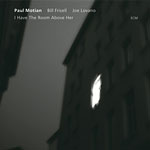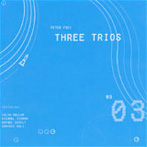Home » Jazz Articles » Profile » Paul Motian: Sound in Motian
Paul Motian: Sound in Motian
It was during his tenure with Jarrett that Motian would truly develop the nascent qualities that today characterize his music.
As a child Motian was surrounded by the sound of Middle Eastern music in the home of his Armenian parents and he often credits the Arabic and Turkish melodies and rhythms of his youth with having a lasting influence on his own idiosyncratic approach to drumming. Born March 25th, 1931, in Philadelphia, he grew up in Rhode Island during the swing era and after a brief flirtation with the guitar he settled down at the drums and became involved in the big band music of the day before falling under the modernist spell of the early beboppers.
"In the beginning people that influenced me were Kenny Clarke and Max Roach and Art Blakey and Philly Joe, the drummer recalls. "They influenced me a lot. I remember going to hear Max Roach and he had Clifford Brown in the band and Sonny Rollins; and hearing Art Blakey when they weren't even called the Messengers and listening to what they were playing and trying to play like them and trying to copy them. And Kenny Clarke and those records with Miles that was some good shit... I listened a lot to those guys and I tried to play like they played. And I guess eventually you evolve and you kind of turn into yourself—you get to be yourself, hopefully.
Motian moved to New York in the mid '50s and worked briefly with Thelonious Monk. The iconoclastic pianist's resolutely individual style had a lasting effect on the drummer's own personal approach to rhythm and composition, which he further developed while working with forward looking artists such as George Russell, Tony Scott and Lennie Tristano. Of the latter he recalls, "He wanted you playing the 4/4 and he'd play around it, which was a challenge for me, it really was. I remember one time playing with him at the old Half Note for 10 weeks and we had a different bassist every week. He changed the bassist every week, man. But he kept me. It was quite an experience.
It was while with Scott and Russell that Motian got his first experience playing with pianist Bill Evans. In 1956 the drummer appeared on Evans' debut date as a leader, but it wasn't until the two started working together with bassist Scott LaFaro a couple of years later that they began earning widespread recognition for their innovative approach to the piano trio format—one in which each member had a nearly equal voice in determining the sound and direction of the music. The Evans-LaFaro-Motian group made several recordings for Riverside, including the classics Waltz For Debby and Sunday at the Village Vanguard, which had a marked influence on legions of jazz pianists.
After LaFaro's tragic death the dynamic of the Evans unit changed and eventually the restless Motian, feeling the need for more freedom and stimulation, left the band and teamed up, first with Paul Bley and then with Keith Jarrett, two of the pianists moving the Evans Trio's concept of group improvisation forward. Motian's conception was also advancing, obviously affected by the bold rhythmic revolutions of Elvin Jones and Sunny Murray, as well as the interactive innovations Billy Higgins and Ed Blackwell were pursuing with Ornette Coleman. Jarrett's trio (which also featured Ornette bassist Charlie Haden) and "great American quartet (that added another Coleman disciple, saxophonist Dewey Redman) would attain a legendary status similar to that achieved the Evans trio a decade earlier.
It was during his tenure with Jarrett that Motian would truly develop the nascent qualities that today characterize his music. The pianist's interest in "world music allowed the drummer to interpolate the Middle Eastern sounds and rhythms he heard growing up into his textural colorist style of percussion, as can well be heard in the quartet's recordings, particularly Survivor's Suite. Jarrett also played an instrumental role in Motian's development as a composer. He remembers, "I had bought Keith's grand piano, which he had had since he was like four or five years old—he sold it to me really, really cheap—and then I started taking piano lessons and composition lessons and that sort of got me started. Next, Jarrett's European producer, Manfred Eicher, offered Motian the opportunity to present his own compositions on a record date for ECM. The debut Conception Vessel revealed the drummer's exceptional writing aptitude and between 1972 and 1984 he recorded a half a dozen excellent records for the label, culminating with It Should Have Happened A Long Time Ago, featuring two then practically unheard of sidemen: guitarist Bill Frisell and saxophonist Joe Lovano.
 The Motian-Lovano-Frisell trio has remained together for 21 years, recording a remarkable series of albums (including tributes to Evans, Monk and Tin Pan Alley) for a variety of different labels. This year the band returned to ECM with I Have The Room Above Her. "There are eight tunes of mine on there that are brand new tunes, the leader proudly proclaims. "That came about because I was home all that time, he says referring to his recent retirement from touring. "That plus I knew that I was doing a record, so that also got me off my ass to write some stuff.
The Motian-Lovano-Frisell trio has remained together for 21 years, recording a remarkable series of albums (including tributes to Evans, Monk and Tin Pan Alley) for a variety of different labels. This year the band returned to ECM with I Have The Room Above Her. "There are eight tunes of mine on there that are brand new tunes, the leader proudly proclaims. "That came about because I was home all that time, he says referring to his recent retirement from touring. "That plus I knew that I was doing a record, so that also got me off my ass to write some stuff. Motian describes his compositional style as such: "What I do is, I'll sit at the piano and I'll fool around for a while until I get something that'll make sense to me, like maybe a short melody, a few notes that come together and kind of build on that. The way it works with Lovano and Frisell, I would get together with them after I had something down and we would rehearse it and play it and it would come together like that. I guess that's how it happens. I don't hear a tune all together. It kind of comes together bit by bit.
He goes through a similar process with another one of his distinctive groups, the Electric BeBop Band. "Yeah, he says, "I'll bring in a lead sheet, give a lead sheet to everybody and then I arrange it. When we play it, then I kind of arrange it, like I'll say okay, we should do it like this: we should play the head, everyone should play and then we'll play it like this, maybe two people will do a duet... These days I don't hardly ever rehearse, he says. "At one time I did rehearse. I was rehearsing early on when I first put the Bebop Band together and I ran into Ornette Coleman on 72nd Street and Broadway and he asked me how I was doing, what I was doing and I said 'Man, I just came back from a rehearsal with the Electric BeBop Band.' I said, 'We're playing bebop tunes and we're playing everything and I had everything, prepared everything in unison' and he said, 'All music is in unison.' I said 'Oh great man (laughing).' I felt really good that I was on the right track.
Motian has remained on the right track with the Electric BeBop Band, a group that originally included the virtually unknown Kurt Rosenwinkel and Joshua Redman, which he says he put together to "destroy bebop. "I wanted to play bebop badly, he laughs. "I wanted to get people that really didn't know it and would play it badly, but it really didn't work out that way... All our stuff keeps growing, man—keeps getting better and better. Since I've added my own music to it... The latest recording we've done hasn't even been mixed yet and that's the one with the three guitars—Jakob Bro, Steve Cardenas and Ben Monder; two saxophones—Tony Malaby and Chris Cheek—and Jerome Harris on bass. And we did it on ECM; the first Electric BeBop Band record that we did on ECM. And we did some of my tunes and I wrote some tunes and then we did some other songs that I don't usually do. I tried to find some things—we did "Pithecanthropus Erectus by Mingus...we did a Monk tune ["Evidence ]. It's a little different, I think.
"Different remains the hallmark of the drummer's work. His Trio 2000 plus one, featuring Masabumi Kikuchi with Chris Potter and Larry Grenadier, recently bedazzled the Village Vanguard with some of the most unusual improvised music ever performed within its hallowed halls. The previous week he was swinging at Dizzy's Club, playing straight time with Joe Lovano, Mulgrew Miller and George Mraz. The month before that the impressionistic textures of his trio with Lovano and Frisell filled Carnegie Hall in a triumphant JVC concert. He's just finished recording a live date with underground tenor saxophonist Bill McHenry at the Vanguard and next month will see the release of trio recordings by Frank Kimbrough, Bobo Stenson and Enrico Rava, each of which include his compositions in addition to his drumming.
Meanwhile Motian is simply enjoying being home in New York—having been off the road for two years. "Somehow, I'm busy enough doing my own stuff with all the different bands, he notes. Asked if it's the variety of playing situations in his life that keeps him young, the 74 year old drummer replies, "Hey, I hope so. I don't know, man. I don't know, but I'm really happy about it. The way I'm playing, what I'm playing, the music that I'm involved with, my writing. As for the future, he says, "I don't really plan shit out. I go with the flow.
Recommended Listening:
· Bill Evans—Sunday at the Village Vanguard (Riverside-OJC, 1961)
· Keith Jarrett—The Survivor's Suite (ECM, 1976)
· Paul Motian—The Story of Maryam (Soul Note, 1983)
· Paul Motian—Monk in Motian (JMT-Winter&Winter, 1988)
· Paul Motian—Bill Evans (JMT-Winter&Winter, 1990)
· Paul Motian & The Electric Bebop Band—Play Monk and Powell (Winter&Winter, 1998)
Tags
PREVIOUS / NEXT
Support All About Jazz
 All About Jazz has been a pillar of jazz since 1995, championing it as an art form and, more importantly, supporting the musicians who make it. Our enduring commitment has made "AAJ" one of the most culturally important websites of its kind, read by hundreds of thousands of fans, musicians and industry figures every month.
All About Jazz has been a pillar of jazz since 1995, championing it as an art form and, more importantly, supporting the musicians who make it. Our enduring commitment has made "AAJ" one of the most culturally important websites of its kind, read by hundreds of thousands of fans, musicians and industry figures every month.

























